Relapse of Multiple Myeloma in the Thyroid Gland
Article Information
Lopez Rojo I*, Gomez Valdazo A, Gomez Ramirez J
Department of General Surgery, Jimenez Diaz University Hospital Foundation, Madrid, Spain
*Corresponding Author: Dr. Irene Lopez Rojo, Department of General and Digestive Surgery, University Hospital Fundacion Jimenez Diaz, Avenue of the Catholic Kings, 2 28040 Madrid, Spain
Received: 24 September 2018; Accepted: 29 September 2018; Published: 29 September 2018
Citation: Lopez Rojo I, Gomez Valdazo A, Gomez Ramirez J. Relapse of Multiple Myeloma in the Thyroid Gland. Journal of Surgery and Research 1 (2018): 63-68.
View / Download Pdf Share at FacebookAbstract
Multiple myeloma (MM) relapse following allotransplantation is rare, and when it does occur, it tends to be located in the bone marrow. Thyroid gland invasion by plasma cells is an uncommon finding in the literature. It is important to be aware that in some patients the disease manifests as apparent solitary extramedullary plasmocytoma, though further investigation reveals a plasma cell tumor in other sites We present a case of relapsed MM presenting as a rapidly growing thyroid mass.
Keywords
Multiple Myeloma relapse, Extramedullary plasmocytoma, Thyroid plasmocytoma, Plasmacytic myeloma
Multiple Myeloma relapse articles Multiple Myeloma relapse Research articles Multiple Myeloma relapse review articles Multiple Myeloma relapse PubMed articles Multiple Myeloma relapse PubMed Central articles Multiple Myeloma relapse 2023 articles Multiple Myeloma relapse 2024 articles Multiple Myeloma relapse Scopus articles Multiple Myeloma relapse impact factor journals Multiple Myeloma relapse Scopus journals Multiple Myeloma relapse PubMed journals Multiple Myeloma relapse medical journals Multiple Myeloma relapse free journals Multiple Myeloma relapse best journals Multiple Myeloma relapse top journals Multiple Myeloma relapse free medical journals Multiple Myeloma relapse famous journals Multiple Myeloma relapse Google Scholar indexed journals Extramedullary plasmocytoma articles Extramedullary plasmocytoma Research articles Extramedullary plasmocytoma review articles Extramedullary plasmocytoma PubMed articles Extramedullary plasmocytoma PubMed Central articles Extramedullary plasmocytoma 2023 articles Extramedullary plasmocytoma 2024 articles Extramedullary plasmocytoma Scopus articles Extramedullary plasmocytoma impact factor journals Extramedullary plasmocytoma Scopus journals Extramedullary plasmocytoma PubMed journals Extramedullary plasmocytoma medical journals Extramedullary plasmocytoma free journals Extramedullary plasmocytoma best journals Extramedullary plasmocytoma top journals Extramedullary plasmocytoma free medical journals Extramedullary plasmocytoma famous journals Extramedullary plasmocytoma Google Scholar indexed journals Thyroid plasmocytoma articles Thyroid plasmocytoma Research articles Thyroid plasmocytoma review articles Thyroid plasmocytoma PubMed articles Thyroid plasmocytoma PubMed Central articles Thyroid plasmocytoma 2023 articles Thyroid plasmocytoma 2024 articles Thyroid plasmocytoma Scopus articles Thyroid plasmocytoma impact factor journals Thyroid plasmocytoma Scopus journals Thyroid plasmocytoma PubMed journals Thyroid plasmocytoma medical journals Thyroid plasmocytoma free journals Thyroid plasmocytoma best journals Thyroid plasmocytoma top journals Thyroid plasmocytoma free medical journals Thyroid plasmocytoma famous journals Thyroid plasmocytoma Google Scholar indexed journals Plasmacytic myeloma articles Plasmacytic myeloma Research articles Plasmacytic myeloma review articles Plasmacytic myeloma PubMed articles Plasmacytic myeloma PubMed Central articles Plasmacytic myeloma 2023 articles Plasmacytic myeloma 2024 articles Plasmacytic myeloma Scopus articles Plasmacytic myeloma impact factor journals Plasmacytic myeloma Scopus journals Plasmacytic myeloma PubMed journals Plasmacytic myeloma medical journals Plasmacytic myeloma free journals Plasmacytic myeloma best journals Plasmacytic myeloma top journals Plasmacytic myeloma free medical journals Plasmacytic myeloma famous journals Plasmacytic myeloma Google Scholar indexed journals Extramedullary plasmocytomas articles Extramedullary plasmocytomas Research articles Extramedullary plasmocytomas review articles Extramedullary plasmocytomas PubMed articles Extramedullary plasmocytomas PubMed Central articles Extramedullary plasmocytomas 2023 articles Extramedullary plasmocytomas 2024 articles Extramedullary plasmocytomas Scopus articles Extramedullary plasmocytomas impact factor journals Extramedullary plasmocytomas Scopus journals Extramedullary plasmocytomas PubMed journals Extramedullary plasmocytomas medical journals Extramedullary plasmocytomas free journals Extramedullary plasmocytomas best journals Extramedullary plasmocytomas top journals Extramedullary plasmocytomas free medical journals Extramedullary plasmocytomas famous journals Extramedullary plasmocytomas Google Scholar indexed journals plasma cell neoplasms articles plasma cell neoplasms Research articles plasma cell neoplasms review articles plasma cell neoplasms PubMed articles plasma cell neoplasms PubMed Central articles plasma cell neoplasms 2023 articles plasma cell neoplasms 2024 articles plasma cell neoplasms Scopus articles plasma cell neoplasms impact factor journals plasma cell neoplasms Scopus journals plasma cell neoplasms PubMed journals plasma cell neoplasms medical journals plasma cell neoplasms free journals plasma cell neoplasms best journals plasma cell neoplasms top journals plasma cell neoplasms free medical journals plasma cell neoplasms famous journals plasma cell neoplasms Google Scholar indexed journals monoclonal serum Ig articles monoclonal serum Ig Research articles monoclonal serum Ig review articles monoclonal serum Ig PubMed articles monoclonal serum Ig PubMed Central articles monoclonal serum Ig 2023 articles monoclonal serum Ig 2024 articles monoclonal serum Ig Scopus articles monoclonal serum Ig impact factor journals monoclonal serum Ig Scopus journals monoclonal serum Ig PubMed journals monoclonal serum Ig medical journals monoclonal serum Ig free journals monoclonal serum Ig best journals monoclonal serum Ig top journals monoclonal serum Ig free medical journals monoclonal serum Ig famous journals monoclonal serum Ig Google Scholar indexed journals positron emission tomography articles positron emission tomography Research articles positron emission tomography review articles positron emission tomography PubMed articles positron emission tomography PubMed Central articles positron emission tomography 2023 articles positron emission tomography 2024 articles positron emission tomography Scopus articles positron emission tomography impact factor journals positron emission tomography Scopus journals positron emission tomography PubMed journals positron emission tomography medical journals positron emission tomography free journals positron emission tomography best journals positron emission tomography top journals positron emission tomography free medical journals positron emission tomography famous journals positron emission tomography Google Scholar indexed journals tumor suppressor gene p53 articles tumor suppressor gene p53 Research articles tumor suppressor gene p53 review articles tumor suppressor gene p53 PubMed articles tumor suppressor gene p53 PubMed Central articles tumor suppressor gene p53 2023 articles tumor suppressor gene p53 2024 articles tumor suppressor gene p53 Scopus articles tumor suppressor gene p53 impact factor journals tumor suppressor gene p53 Scopus journals tumor suppressor gene p53 PubMed journals tumor suppressor gene p53 medical journals tumor suppressor gene p53 free journals tumor suppressor gene p53 best journals tumor suppressor gene p53 top journals tumor suppressor gene p53 free medical journals tumor suppressor gene p53 famous journals tumor suppressor gene p53 Google Scholar indexed journals tissue biopsy articles tissue biopsy Research articles tissue biopsy review articles tissue biopsy PubMed articles tissue biopsy PubMed Central articles tissue biopsy 2023 articles tissue biopsy 2024 articles tissue biopsy Scopus articles tissue biopsy impact factor journals tissue biopsy Scopus journals tissue biopsy PubMed journals tissue biopsy medical journals tissue biopsy free journals tissue biopsy best journals tissue biopsy top journals tissue biopsy free medical journals tissue biopsy famous journals tissue biopsy Google Scholar indexed journals
Article Details
1. Introduction
Extramedullary plasmocytomas (EMP) represent 5% of plasma cell neoplasms and are those which arise in tissues other than bone marrow. Thyroid-gland involvement by plasma cell neoplasms is extremely rare in the literature, and when this disease does occur, it usually appears as a solitary extramedullary plasmocytoma (SEP) in the setting of longstanding Hashimoto’s disease [1]. Symptoms related to SEP include local compressive symptoms, rapid nodule involvement, and hoarseness, with most patients presenting monoclonal serum Ig [2].
2. Case Report
A 58-year-old man with a 10-year history of IgG multiple myeloma (MM) reported to our outpatient clinic with complaints of cervical occupancy of two months’ duration with associated dysphonia and right vocal cord palsy with no dysphagia or dyspnea.
In the 11-year period before presenting to our department, the patient was first treated with VBMCP Chemotherapy (Vincristine,Melphalan, Cyclophosphamide, Prednisone). Afterwards, he was treated with autologous stem cell transplantation (conditioned with melphalan) twice, with partial response to it. He was on maintenance first with interferon, and with Thalidomide and bortezomib after bone marrow progression. Finally, he was treated with related donor allotransplantation conditioned with Melfalan and Fludarabina, without acute complications and achieving complete remission proved by immunofluorescence testing. Levels of kappa light chains were elevated during follow-up, with negative results on urine and plasma immunofluorescence testing.
An ultrasound scan of the neck showed a 5 cm × 2.3 cm mass located in the right lobe of the thyroid gland, with micro- and macrocalcifications, 1-cm lymph nodes located in I and II cervical regions, presumably indicating extrathyroid invasion (Figure 1).
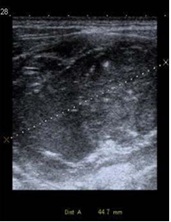
Figure 1:Neck ultrasound scan: right thyroid lobe enlarged by a 5 × 2.3-cm solid, irregular nodule withmicro- and macrocalcifications.
Due to the high suspicion of malignancy, a positron emission tomography (PET-CT) scan was performed, identifying a cervical mass (SUV 14.8) with destruction of the thyroid cartilage and a moth-eaten appearance of the axial skeleton, pelvis, shoulder, sternum, and D7-D11 vertebrae (Figures 2 and 3).
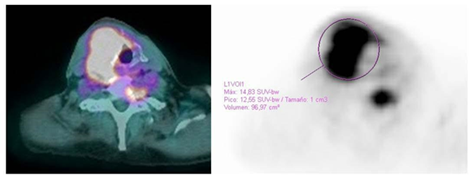
Figure 2:PET/CT scan showing a cervical mass (SUV 14.8) suggestive of malignancy.
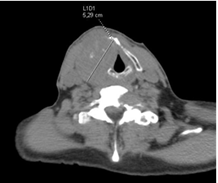
Figure 3:CT scan showing a 52-mm soft tissuedensity mass in the right thyroid lobe with thyroid cartilage destruction. No pathologic adenopathy is evidenced.
A 2-cm surgical biopsy taken of the thyroid mass revealed presence of multinucleated plasma cells positive for CD38, CD138, CD56, MUM1, and MYC, and negative for EBV, CD4, CD3, CD8, and CD20 (Figure 4).
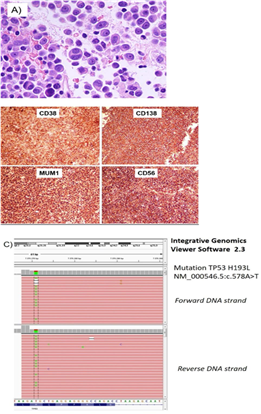
Figure 4:(A) Plasmacytoid tumor cells with eosinophilic cytoplasm, large nuclei, and prominentnucleoli. Some of the cells were bi- or tri-nucleated and showed atypia; (B) Tumor cells expressed plasmatic differentiation (CD38, CD138, and MUM1) and plasma-cell neoplasm immunohistochemistry (CD56, MYC, and P53); (C) Molecular study of the p53 protein identified a Tp53 inactivating mutation NM_000546.5:c.578A>T: p.His193Leu.
This finding suggests plasmacytic myeloma, proving inactivating mutations of the tumor suppressor gene p53 on Trusight panel (exon 6). Clinical findings were compatible with multiple myeloma relapse on bone and secundary thyroid gland plasmocytoma. As a result, the patient was treated with bortezomib and cyclophosphamide combined with radiation therapy to decrease the risk of spinal cord compression. He presented oral mucositis and repeated respiratory infection, forcing discontinuation of chemotherapy, though all planned radiation treatment sessions were performed. Eighteen months later, a follow-up test showed a reduction in the mass to 1.06 cm (SUVmax 3.9) and an improvement in lytic bone lesions, suggesting good response to treatment (Figures 5 and 6).
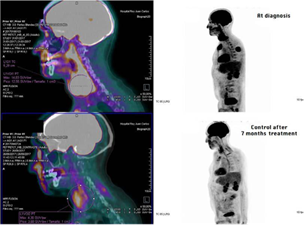
Figure 5:Follow-upPET scan 7 months postoperatively, demonstrating the reduction in the thyroidmass and caption decrease (SUV max 3.9). Lytic bone lesions showed a reduction in number and in associated soft-tissue thickening, suggesting good metabolic response to treatment.
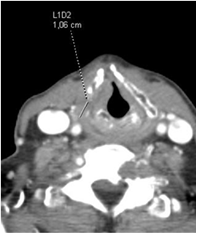
Figure 6:Follow-up CT scan obtained 7 months postoperatively showing a reduction in the size of thethyroid mass (size 1.06 cm).
3. Discussion
It is important to be aware that in some patients the disease manifests as apparent solitary extramedullary plasmocytoma, though further investigation reveals a plasma cell tumor in other sites. In other sites, as it occured in the presented case, where the PET-CT ruled out an exclusive affectation of the thyroid gland. Differential diagnosis of solitary extramedullary plasmocytoma of the thyroid should include rapidly enlarging masses such as inflammatory pseudotumor plasma cell variant (plasma cell granuloma), extranodal marginal zone B cell lymphoma, non-Hodgkin lymphoma, anaplastic and medullary thyroid cancer, and MM [3]. The main diagnostic challenge is to rule out systemic MM separation and distinguish this entity from SEP, given that one third of the patients with extramedullary plasmocytoma have underlying MM. In our case, the differential diagnosis was simpler when the patient had a diagnosis of MM. Solitary extramedullary plasmocytomas could achieve complete remission by radiation therapy alone but, when resectable, surgery remains the treatment of choice. Our patient had signs of local invasion, so the surgical option was discarded at least at the beginning. The gold standard diagnostic test for diagnosis of EMP is tissue biopsy [4].
Recurrence is a major cause of allogenic stem cell transplantation failure, the only potential curative treatment for MM. It is usually a bone relapse, but from time to time it presents as an isolated extramedullary plasmocytoma. In patients with extramedullary plasmocytomas, tumors develop either as direct extensions of bone tumors when they break cortical bone or as a nodular deposit of plasma cells, which develop autocrine supportive loops, allowing them to become stromal independent [5]. Late and localized relapse after transplantation could be explained by the persistence of foci of disease on immunologically privileged sites or by the selection of different subclones. Extramedullary relapse is more frequent after allogeneic transplantation rather than autologous stem cell transplantation in patients treated with novel drugs or with extramedullary disease at diagnosis. Isolated elevation of serum or urinary paraprotein could be a marker of this type of late relapse. When suspected, PET-CT scan is a valuable tool for diagnosis and follow-up.
Treatment options are limited for patients with localized relapse of MM after stem cell transplantation, and therefore, have worse prognosis. Immunotherapy and radiation therapy should be considered, and as an alternative option thalidomide and bortezomib could be chosen. Low-dose radiation therapy and surgery become an option when there is airway compression or vital organ involvement [6]. As mentioned before, the combination of bortezomib, immunotheraphy and radiation in the presented case, resulted in a good response in the 24-month follow-up. MM with extramedullary disease throughout the course of the illness indicate poor prognosis, and it is associated with shorter progression-free and overall survival [7].
4. Conclusions
Myeloma relapse is commonly preceded by a rise in blood or urine paraprotein levels. PET/CT scan is useful in these cases, allowing diagnosis and location of pauci-symptomatic or late relapse. Even though myeloma relapse manifesting as extramedullary plasmacytoma is rare, this entity should remain part of the differential diagnosis of neck masses when patient history includes myeloma, even in cases of complete remission. Additionally, plasma-cell proliferation on thyroid tissue should lead clinicians to rule out a plasma-cell tumor in other sites (specially bone marrow) and exclude the possibility of MM.
Acknowledgements
Our gratitude to Oliver Shaw, who helped us with the translation of the article.
References
- Ozdemir E, Bayraktar M, Sökmensüer C, et al. Late relapse of a light-chain myeloma as extramedullary plasmacytoma of the thyroid gland after second allogeneic stem-cell transplantation. Clin Transplant 23 (2009): 981-984.
- Avila A, Villalpando A, Montoya G, et al. Clinical features and differential diagnoses of solitary extramedullary plasmacytoma of the thyroid: a case report. Ann DiagnPathol 13 (2009): 119-123.
- Mertens de Wilmars M, Knoops L, Sempoux C, et al. Solitary extramedullary plasmocytoma of the thyroid: A case report and histological approach to plasma cells infiltrate in the thyroid gland. Acta Clin Belg 70 (2015): 133-137.
- Singh K, Kumar P, Pruthy R, et al. Multiple Myeloma Presenting as Thyroid Plasmacytoma. Indian Journal of Medical and Paediatric Oncology: Official Journal of Indian Society of Medical & Paediatric Oncology 38 (2017): 552-554.
- Blade J, Fernandez de Larrea C, Rosiñol L, et al. Soft-tissue plasmacytomas in multiple myeloma: incidence, mechanisms of extramedullary spread, and treatment approach, J ClinOncol 29 (2011): 3805-3812.
- Kumar N, Pandey A.N, Kashyap R, et al. Extramedullary relapse in a case of multiple myeloma involving the thyroid cartilage: case report and review of literature. Indian J Surg Oncol 2 (2012): 313-315.
- Weisser F, Reuter C, Taverna C. Extramedullary manifestations of multiple myeloma in the thyroid gland and in the lungs: Excellent response to therapy. Annals of Hematology 89 (2010): 1183-1184.
